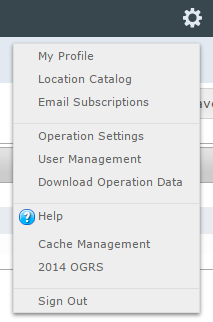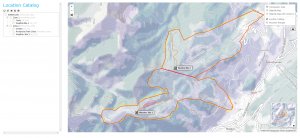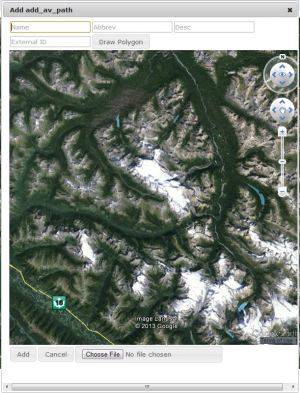Difference between revisions of "Adding locations to the location catalog"
Jump to navigation
Jump to search
(→Related documents) |
(→Step-by-step description) |
||
| Line 31: | Line 31: | ||
* Description: Detailed description of the location | * Description: Detailed description of the location | ||
* External ID: The external ID of a location is required if your operation submits their observations from an external database system via the API (see [[How to submit observation to the InfoEx via the CAAML 3.0.3 API]] for more information). The external ID is also required for location that already existed in the legacy CAAML driven InfoEx and have historic observation associated with them. | * External ID: The external ID of a location is required if your operation submits their observations from an external database system via the API (see [[How to submit observation to the InfoEx via the CAAML 3.0.3 API]] for more information). The external ID is also required for location that already existed in the legacy CAAML driven InfoEx and have historic observation associated with them. | ||
| + | * Elevation (weather site only): Elevation of weather site in meters. | ||
{{Note|Since locations are primarily referred to by name in the InfoEx system, it is not advisable to create multiple location of the same type with the same name. However, the system currently does not explicitly check for it.|NoteNoImage}} | {{Note|Since locations are primarily referred to by name in the InfoEx system, it is not advisable to create multiple location of the same type with the same name. However, the system currently does not explicitly check for it.|NoteNoImage}} | ||
|- | |- | ||
Revision as of 19:01, 21 October 2013
| REQUIREMENTS | |
| Permission | Operation Administrator or higher |
| Connectivity | Online only |
This document describes how to add locations to the location catalog of your operation.
Step-by-step description
| 1. | Select the Location Catalog from the administration menu (cog wheel) in the top left corner of the screen (Fig. 1). To have access to this menu item, you need to be either an operation administrator or a super user. | ||||
| 2. | This will get you to the location catalog screen of the application (Fig. 2). Please note that depending on your connectivity and the size of your location catalog, it might take a while to start Google Earth and load your entire location catalog. The location catalog screen shows your location hierarchy tree on the right and a Google Earth map on the right.
| ||||
| 3. | Expand the location hierarchy tree on the right as required by clicking on the little plus (+) signs left of locations that contain other locations.
| ||||
| 4. | Right click on the parent location of the new location and select New and the desired location type from the menu. See Location hierarchy for a detailed list on what locations can be created under what types of locations. This will open a pop-up window with a second Google Earth map (Fig. 3).
| ||||
| 5. | Enter the following information for the new location into the fields at the top of the pop-up window:
| ||||
| 6. | Add an appropriate geometry to the location. See Location types and symbology for details on the supported geometries for the different location types.
There are currently two options for adding geometries to a location:
| ||||
| 7. | Click on Add to add the new location to the location tree of the operation. This will close the pop-up window and add the new location to the location tree.
|
Related documents
- Deleting locations from the location catalog
- Editing locations in the location catalog
- Creating a hierarchy among your locations
- Searching for locations in the location catalog
Functionality tested by
- Sept. 22: Pascal Haegeli / QA Server / Test Version 0.27.00)


